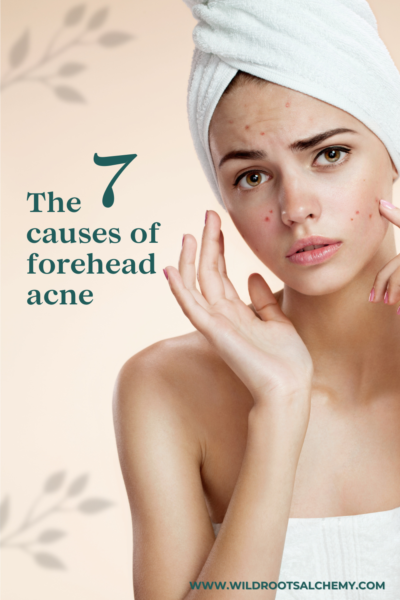
Did you know that acne and period problems are often closely related??
Period problems indicate hormone imbalances that are correlated with acne.
But wait…what are period problems?
Most ladies go through their whole menstruating years dealing with abnormal periods, not even recognizing them as a problem since their symptoms are so common (painful periods, I’m looking at you!).
Spoiler alert: While period problems are common, they’re certainly not normal! And they often indicate that something’s up with your hormonal health.
Your menstrual health is a reflection of your overall state of health, including your skin. If your period is giving you problems, however major or mild, that gives you clues as to 1) which hormones are out of balance, and 2) how to heal your skin, your menstrual issues, and your whole awesome self!
These are some of the most common period problems (leave a comment below if you experience any of these!):
- Heavy menses (more than 80 ml of blood loss per period or longer than 7 days of bleeding)
- Light menses (less than 30 ml of blood loss per period or shorter than 3 days of bleeding)
- Irregular menses (doesn’t occur at regular intervals, i.e. every 28 days)
- Short menstrual cycle (less than 28 days)
- Long menstrual cycle (longer than 35 days)
- Painful periods
- Clots (often associated with heavy menstrual bleeding)
- PMS (including mood swings, headaches, acne flares, breast tenderness, and fatigue that occur just before your period)
- Spotting between periods
- What menses?! (you can go months without a period, or your period is MIA after stopping hormonal birth control)
Let’s break down each common period problem and what this might mean in terms of hormonal imbalances.

Heavy periods
Heavy menstrual bleeding is when you have more than 80 ml of blood loss per period. You can figure out how much blood loss you’re experiencing easily if you use a menstrual cup (they usually hold 30 ml when full). You can also estimate your blood loss if you use tampons (a super tampon holds about 15 ml). Your menses is probably too heavy if you’re changing out a soaked super tampon more than every 3 hours.
A period that lasts longer than 7 days with a moderate flow may also be considered heavy menstrual bleeding if you bleed more than 80 ml. However, if you bleed moderately for 3 days and spot for 5 days afterwards, that’s unlikely to be heavy menstrual bleeding.
Heavy periods are often a sign of high estrogen, as estrogen is responsible for building up the endometrial lining of your uterus, and a thicker endometrial lining is usually responsible for heavier bleeding. This period problem can also be due to low progesterone (which naturally puts your body in a more estrogen-dominant state) or thyroid dysfunction.
Light periods
Light periods are when you experience less than 30 ml of blood loss per period, or you bleed less than 3 days. A menses that is 2 days long with 30 ml or less of blood loss would be considered a light period.
Since estrogen is the hormone responsible for plumping up the uterine lining, light periods are typically associated with estrogen deficiency. Thyroid and adrenal dysfunction are also possible.
Irregular periods
A menstrual cycle normally occurs at regular intervals (like every 28-30 days). If you notice that your menstrual cycle isn’t predictable—maybe it ranges from every 30-45 days—you’ve got irregular menses.
Irregular periods can be due to a variety of hormonal imbalances, including high or low estrogen, low progesterone, thyroid dysfunction, high androgens (as often seen in PCOS or polycystic ovary syndrome), high insulin levels and blood sugar dysregulation, and HPA axis (hypothalamus-pituitary-adrenal) dysfunction.
Short menstrual cycles
Menstrual cycles are normally 28-35 days long. Short menstrual cycles are less than 28 days (often less than 26 days). This could indicate a lack of ovulation or a shortened luteal phase (the luteal phase is the second half of your cycle, or the two-week period of time between when you ovulate and when your period starts).
There are a variety of reasons why your menstrual cycle could be short, including low estrogen status (menstrual cycles typically shorten as you get closer to menopause), thyroid dysfunction, and elevated cortisol or HPA axis dysfunction (stress is a biggie!).
Luteal phase defect (a short luteal phase less than 10 days in length) is due to low progesterone production, even in the presence of regular ovulation.
Long menstrual cycles
Long menstrual cycles are longer than 35 days. This usually means that either:
1) your cycles are anovulatory (no egg release happens), or
2) the follicular phase (the period of time from day 1 of your period to when you ovulate, which should be about 14-16 days long) is longer than normal because your body was having a challenging time maturing a follicle for egg release (a.k.a. the big O…ovulation!)
If you don’t ovulate, your ovaries don’t produce a corpus luteum, which is responsible for progesterone production during the second half of your cycle. Progesterone matures the thickened uterine lining and increases its vascularization (blood vessel formation), preparing your uterus for possible pregnancy. If there’s no progesterone, the uterine lining doesn’t get the signal to mature, and the lack of rising and falling progesterone levels doesn’t trigger your menses to start. This can also lead to irregular periods.
Other hormonal causes of long menstrual cycles include HPA axis dysfunction and cortisol dysregulation, thyroid dysfunction, and elevated androgens (i.e. PCOS).
Painful periods (dysmenorrhea)
Ahh, painful periods!!! So common, yet so problematic. Periods should NOT be painful, and they should most definitely not be confining you to your bedroom for days on end or require massive amounts of Advil. Period pain is a huge red flag that something is up with your health!
There are many different causes of painful menses, including hormonal imbalances like estrogen dominance or low progesterone. Painful periods can also indicate physical problems like endometriosis, adenomyosis, fibroids, or pelvic stagnation.
Tip: Maya abdominal therapy and pelvic floor therapy are great manual techniques to help alleviate painful periods!
Clots
Often associated with heavy menstrual bleeding, clots can be a sign of a thickened uterine lining, certain hormonal imbalances, and pelvic stagnation.
Clots usually indicate estrogen dominance, as estrogen is the hormone that signals proliferation of the uterine lining. If the uterine lining is thicker than normal, that increases the likelihood of clot formation.
Clots can also point to low progesterone (putting the body in an estrogen dominant state) or poor thyroid function.
PMS (Premenstrual Syndrome)
PMS symptoms like mood swings, headaches, acne flares, breast tenderness, and fatigue that occur just before your period are common, but they’re definitely a sign that something isn’t right!
Different PMS symptoms indicate different hormonal imbalances, including imbalances in estrogen, progesterone, androgens, cortisol, and insulin and blood sugar levels.
Spotting between periods
Some women may experience brief, light bleeding around the time they ovulate, which is due to a shift in the naturally fluctuating levels of estrogen and progesterone at this time. This may not indicate any hormonal problems, unless it occurs along with other symptoms of hormonal imbalance.
If spotting occurs a few days before you expect your period to arrive, this may be implantation bleeding and is one of the first signs of pregnancy. This is when the fertilized egg implants itself into the lining of your uterus and triggers a mild bleed in the process. If the spotting is light and only lasts a day or two, this is normal.
Abnormal spotting is when you experience breakthrough bleeding between periods that persists or is heavier in flow. This can be caused by physical problems like polyps, adenomyosis, uterine fibroids, and coagulation disorders. It may also indicate ovulatory dysfunction and issues with the hypothalamic-pituitary-ovarian (HPO) axis, low progesterone, cortisol dysregulation, and thyroid dysfunction.
If abnormal spotting is ever accompanied by pelvic pain, make sure to seek medical care!
Absent menses (amenorrhea)
Does your period disappear for months at a time?
Have you recently discontinued hormonal birth control and your period is MIA?
First, test for pregnancy if that’s a possibility! And then speak with a practitioner who can help get your period back, because regular ovulation and menstruation is SO IMPORTANT for your overall health and vitality, regardless if you ever plan on pregnancy.
So what can cause amenorrhea (or absent menstruation)?
Amenorrhea can be due to PCOS, thyroid dysfunction, HPO and HPA axes dysfunction, elevated cortisol levels, blood sugar dysregulation, and elevated prolactin.
As joyous as you may be to never see blood in your undies or use a tampon ever again, make sure to seek medical advice if you haven’t seen your period in awhile. Your menses is your fifth vital sign, and if you don’t have one, this indicates that something is wrong and you should get it addressed ASAP.
Does the color of my menses matter?
Yes! The color of your blood is an indicator of your menstrual health. Your menstrual blood should ideally by bright red, but it can range from a lighter red to dark red.
If your menses is purple, this indicates pelvic stagnation and often estrogen dominance.
Pink blood reveals either poor circulation to the uterus, low estrogen, or anemia or blood nutrient deficiency.
Dark brown indicates that the blood has been oxidized, pointing to pelvic stagnation. Dark brown blood is often old blood that has just been hanging out in the uterus, which may mean the uterus is malpositioned and having a hard time properly eliminating during menstruation. (Maya abdominal therapy is a great way to reposition your uterus!)
So how does this relate to acne??

If you have acne and you’ve also got any of these period problems, the pattern of your symptoms can give us incredibly useful insight into what hormonal imbalances are triggering your acne. And if you can fix your periods, you can heal your skin!
It’s all about getting to the root of what’s going on with your hormones so you can restore healthy menses and clear your skin.
It’s amazing how much you can gather just from interpreting your symptoms, which are your body’s way of communicating what’s out of balance. Get good at listening to and reading your body’s language, and you have the key to your health right there!
Interested to know what your primary hormonal imbalance could be? I’ve created a FREE quiz to help you figure it out! You’ll discover your primary hormonal imbalance, and you’ll receive my free ebook (7 Steps to Healing Acne Naturally) along with a ton of awesome tips geared towards your specific imbalance.
Now that you know some of the common period problems and what they mean, what do you think is going on with your hormones? Let me know below!





